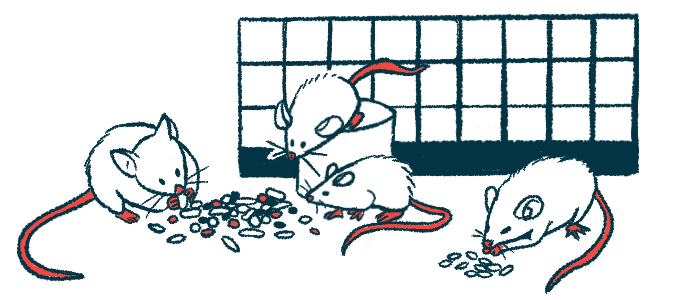MicroRNA-based Gene Therapy for CMT1A Shows Promise in Mice

A gene therapy designed to reduce the levels of PMP22 — the protein overly produced in Charcot-Marie-Tooth disease type 1A (CMT1A) — significantly lessened functional deficits in a mouse model of the disease, a study shows.
The approach, based on an artificial microRNA (miRNA) molecule, was found to significantly reduce both mouse and human PMP22 protein levels. It also was effective when delivered directly into the animals’ spinal canal — an approach that potentially could be used in the future for human patients.
“These results constitute an important step towards the development of a clinically relevant and translatable gene therapy to treat CMT1A,” the researchers wrote.
While the findings support the therapeutic potential of this gene therapy for CMT1A patients, future studies in larger animals are needed before it can be tested in clinical trials, the team noted.
The study, “A translatable RNAi-driven gene therapy silences PMP22/Pmp22 genes and improves neuropathy in CMT1A mice,” was published in The Journal of Clinical Investigation.
CMT is a group of inherited disorders that affect the peripheral nervous system, which controls movement and sensation in the limbs. The most common subtype, CMT1A, is caused by a duplication of the PMP22 gene.
PMP22 provides instructions to make a protein of the same name that’s a key component of myelin, the protective sheath around nerve fibers that enables fast neuronal communication. Excess PMP22 protein not only affects myelin’s structure, but also triggers the death of Schwann cells, the cells that produce myelin in peripheral nerves — those that send signals from the brain and spinal cord to the rest of the body.
This leads to myelin loss, or demyelination, as well as nerve cell damage and disability.
A number of therapies designed to reduce PMP22 levels are being developed for CMT1A, but none has been approved to date. In addition, while several have shown promise in mouse models of the disease, their ability to reduce human PMP22 levels remains unclear.
Now, a team of researchers in Cyprus, the U.S., the U.K., and Sweden designed and tested a potentially translatable gene therapy approach for CMT1A. It’s based on a new artificial miRNA that can target both mouse and human PMP22.
miRNAs are small RNA molecules that target a specific gene’s messenger RNA (mRNA) — the molecule derived from DNA that guides protein production — to prevent generation of that protein.
Natural miRNAs can be modified in the form of artificial miRNAs and retargeted to specific disease-associated genes, triggering their mRNA for degradation.
The researchers first identified microRNA 871 (miR871) as the best of eight miRNAs they designed to target conserved regions between mouse and human PMP22 mRNA molecules. These tests were done in lab-grown human cells modified to produce both mouse and human PMP22 proteins.
The team then evaluated the effects of administering a one-time gene therapy based on miR871 to a mouse model of CMT1A carrying both the mouse and human versions of the PMP22 gene.
The therapy uses a modified and harmless adeno-associated virus type 9 (AAV9) to deliver to cells a DNA sequence coding for miR871. It was given directly into the animals’ spinal canal — “a route of administration that can be translated to human trials,” the researchers wrote.
Results showed that the gene therapy successfully delivered miR871’s DNA sequence to Schwann cells in peripheral nerves. It also significantly reduced both mouse and human PMP22 mRNA and protein levels in these mice.
Also, treatment at both early and late stages of the disease — both after symptom onset — significantly improved multiple functional outcome measures and nerve cell signal transmission at four to eight months after dosing.
Both approaches also were associated with significant reductions in the percentage of thinly myelinated and demyelinated nerve fibers, and the blood levels of nerve damage biomarkers. The number of immune cells in peripheral nerve tissue also was significantly reduced, suggesting lower inflammatory responses.
These treatments were meant to resemble “the clinical scenario of treating younger or older patients suffering from CMT1A, in whom demyelination is already present in childhood, followed by slowly progressive [nerve fiber] loss,” the researchers wrote.
However, only early treatment resulted in improvements that reached levels seen in healthy mice, emphasizing the importance of treating patients as early as possible to prevent irreversible damage.
Also, neither approach was associated with chronic inflammatory responses in the liver, which are a common side effect of virus-based gene therapies.
These findings highlight that a single spinal canal injection of this gene therapy after symptom onset “can correct the functional, morphological and inflammatory abnormalities of CMT1A without causing any apparent side effects,” the researchers wrote.
“Taken together, our data demonstrate that [this experimental treatment] rescues a CMT1A model and provides proof of principle for treating CMT1A using a translatable gene therapy approach,” they concluded.
Further studies in larger animals are needed, the team noted.







